|
|
|
 |
 |
 |
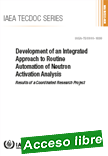 |
Development of an Integrated Approach to Routine Automation of Neutron Activation Analysis - Results of a Coordinated Research Project
IAEA TECDOC, 2018, 68 p.
Neutron activation analysis (NAA) is a powerful technique for determining bulk composition of major and trace elements. Automation may contribute significantly to keep NAA competitive for end-users. It provides opportunities for a larger analytical capacity and a shorter overall turnaround time if large series of samples have to be analysed. This publication |
documents and disseminates the expertise generated on automation in NAA during a coordinated research project (CRP). The CRP participants presented different cost-effective designs of sample changers for gamma-ray spectrometry as well as irradiation devices, and were able to construct and successfully test these systems. They also implemented, expanded and improved quality control and quality assurance as crosscutting topical area of their automated NAA procedures. The publication serves as a reference of interest to NAA practitioners, experts, and research reactor personnel, but also to various stakeholders and users interested in basic research and/or services provided by NAA. The individual country reports are available on the CD-ROM attached to this publication.
|
 |
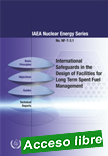 |
International Safeguards in the Design of Facilities for Long Term Spent Fuel Management - Technical Reports
IAEA Nuclear Energy Series, 2018, 70 p.
This publication is the fifth in the IAEA Nuclear Energy Series to provide guidance on the inclusion of safeguards in nuclear facility design and construction. It is principally intended for designers and operators of facilities for long term spent fuel; however, vendors, national authorities and financial backers can also benefit from the information provided. The publication |
complements the general considerations addressed in International Safeguards in Nuclear Facility Design and Construction, IAEA Nuclear Energy Series No. NP-T-2.8.
|
 |
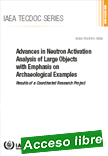 |
Advances in Neutron Activation Analysis of Large Objects with Emphasis on Archaeological Examples - Results of a Coordinated Research Project
IAEA TECDOC, 2018, 72 p.
This publication is a compilation of the main results and findings of an IAEA coordinated research project (CRP). In particular, it discusses an innovative variation of neutron activation analysis (NAA) known as large sample NAA (LSNAA). There is no other way to measure the bulk mass fractions of the elements present in a large sample (up to kilograms in
|
mass) non-destructively. Examples amenable to LSNAA include irregularly shaped archaeological artefacts, excavated rock samples, large samples of assorted ore, and finished products, such as nuclear reactor components. Advantages of LSNAA applications, limitations and scientific and technological requirements are described in this publication, which serves as a reference of interest not only to the NAA experts, research reactor personnel, and those considering this technique, but also to various stakeholders and users such as researchers, industrialists, environmental and legal experts, and administrators.
|
 |
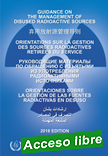 |
Guidance on the Management of Disused Radioactive Sources
IAEA Non-serial Publications , April 2018, 180 p.
Paragraph 5(b) of the Code of Conduct on the Safety and Security of
Radioactive Sources (the Code) states that the objectives of the Code “should be
achieved through the establishment of an adequate system of regulatory control
of radioactive sources, applicable from the stage of initial production to their
final disposal, and a system for the restoration of such control if it has been
lost.” Paragraph 7(a) indicates
|
that every State should take the appropriate
measures necessary to ensure “that the radioactive sources within its territory, or
under its jurisdiction or control, are safely managed and securely protected
during their useful lives and at the end of their useful lives.” Paragraphs 14, 15,
20, 22 and 27 also contain provisions that are directly relevant to the
management of disused sources.
1. Within the context of the overall lifecycle management of radioactive
sources, the objective of this Guidance is to encourage States to improve
the safety and security of disused sources in line with the provisions of
the Code. The intent is to identify actions to be taken, starting with the
decision to acquire a radioactive source and continuing through disposal,
to ensure that disused sources are safely and securely managed.
2. This Guidance is intended to advise States on the available management
options for disused sources. These options, described further in this
Guidance, include reuse or recycling, long-term storage and disposal and
return to a supplier. Short-term storage and transport, which are addressed
in this Guidance, are not considered as options in themselves, but are
often necessary interim steps in the implementation of options.
3. While the return to a supplier is also considered as an option, the
objective of this Guidance is neither to place the sole responsibility for
the management of disused sources on the Supplier State nor to ascribe
obligations on these States to take back sources they may have previously
supplied.
|
 |
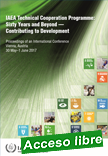 |
IAEA Technical Cooperation Programme: Sixty Years and Beyond — Contributing to Development - Proceedings of an International Conference Held in Vienna, 30 May–1 June 2017
IAEA Proceedings Series - International Atomic Energy Agency , 2018, 100 p.
These proceedings detail how the TC programme has contributed to the establishment of national nuclear infrastructure and capabilities in Member States over six decades, in support of their national development priorities. |
The publication also presents examples of successful partnerships and looks to the future regarding appropriate approaches and concrete measures that will help countries to maximize their use of nuclear science and technology in achieving their development goals, including sustainable development goal targets. Key thematic areas covered include the application of nuclear science and technology in human health and nutrition, food and agriculture, water and the environment, radiation technology, energy and safety. Common issues relating to regional collaboration and networking are presented, as is the IAEA and Member States' approach to building lasting and mutually beneficial partnerships.
|
 |
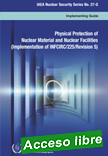 |
Physical Protection of Nuclear Material and Nuclear Facilities (Implementation of INFCIRC/225/Revision 5)
IAEA Nuclear Security Series, 2018, 120 p.
This publication is the lead Implementing Guide in a suite of guidance on implementing the Nuclear Security Recommendations on Physical Protection of Nuclear Material and Nuclear Facilities (INFCIRC/225/Revision 5), IAEA Nuclear Security Series No. 13. It provides guidance and suggestions to assist States and their competent authorities in establishing,
|
strengthening and sustaining their national physical protection regime and implementing the associated systems and measures, including operators’ physical protection systems.
|
 |
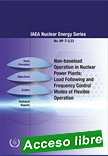 |
Non-baseload Operation in Nuclear Power Plants: Load Following and Frequency Control Modes of Flexible Operation
IAEA Nuclear Energy Series, 2018, 173 p.
This publication aims to address all relevant aspects of flexible (non-baseload) operation of nuclear power plants (NPPs) specifically focusing on changing electrical output to match the electrical demand and to control the frequency of the electrical system. It provides collective guidance based on current knowledge and operational experience, for the decision |
making, preparation and implementation of flexible operation for Member States who are considering future flexible operations of their NPPs.
|
 |
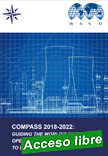 |
Compass 2018-2022
World Association of Nuclear Operators (WANO), October 2017, 20 p.
Compass is WANO's long-term plan for the years 2018-2022, consisting of four focus areas. Every initiative or project undertaken by any WANO office or regional centre supports at least one of the four focus areas. |
|
 |
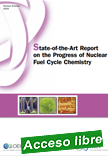 |
State-of-the-art Report on the Progress on Nuclear Fuel Cycle Chemistry
Nuclear Energy Agency (NEA), 19/03/18, 291 p.
The implementation of advanced nuclear systems requires that new technologies associated with the back end of the fuel cycle are developed. The separation of minor actinides from other fuel components is one of the advanced concepts being studied to help close the nuclear fuel cycle and to improve the long term effects on the performance of geological repositories. Separating spent fuel elements and
|
subsequently converting them through transmutation into short lived nuclides should considerably reduce the long-term risks associated with nuclear power generation.
R&D programmes worldwide are attempting to address such challenges, and many processes for advanced reprocessing and partitioning minor actinides are being developed. This report provides a comprehensive overview of progress on separation chemistry processes, and in particular on the technologies associated with the separation and recovery of minor actinides for recycling so as to help move towards the implementation of advanced fuel cycles. The report examines both aqueous and pyro processes, as well as the status of current and proposed technologies described according to the hierarchy of separations targeting different fuel components. The process criteria that will affect technology down selection are also reviewed, as are non proliferation requirements. The maturity of different reprocessing techniques are assessed using a scale based on the technology readiness level, and perspectives for future R&D are reviewed.
|
 |
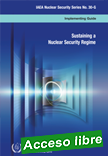 |
Sustaining a Nuclear Security Regime - Implementing Guide
IAEA Nuclear Security Series, 2018, 26 p.
This publication addresses the sustainability of all aspects of a national nuclear security regime, including those relating to nuclear material and nuclear facilities, other radioactive material and associated facilities, and nuclear and other radioactive material out of regulatory control. The publication is relevant for States that have established a nuclear security regime as well as for States that are in the process of establishing
|
one. It includes guidance on how to address challenges in sustaining a nuclear security regime over time. It also addresses the initial development and implementation of the regime, particularly where sustainability can be built into it as part of its design.
|
 |
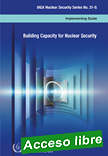 |
Building Capacity for Nuclear Security - Implementing Guide
IAEA Nuclear Security Series, 208, 62 p.
Each State has the primary responsibility to build the capacity of organizations and people in order to develop, implement, and sustain a nuclear security regime. To discharge its responsibilities, the State has to strengthen its capacity at national, organizational and individual levels. Specifically, the State has to be able to enhance the competences and capabilities of relevant stakeholders in fulfilling their responsibilities within the nuclear security regime.
|
Such endeavour involves various elements in capacity building, ranging from education and training to the development of a knowledge network. This publication is intended to serve as a reference document for Member States to develop a national capacity building strategy for nuclear security. It addresses all organizations involved in nuclear security and reflects the multidisciplinary and cross-institutional nature of this task, as well as the long term efforts that are required.
|

|
|
|
| |
|
|
| |
| |
|
|
| |
| |
|
|
| |
| |
|
|
|
|
|
|
|
